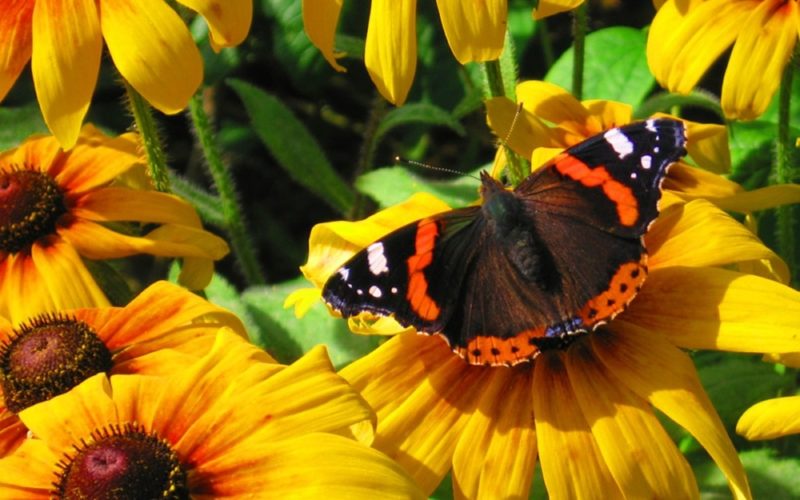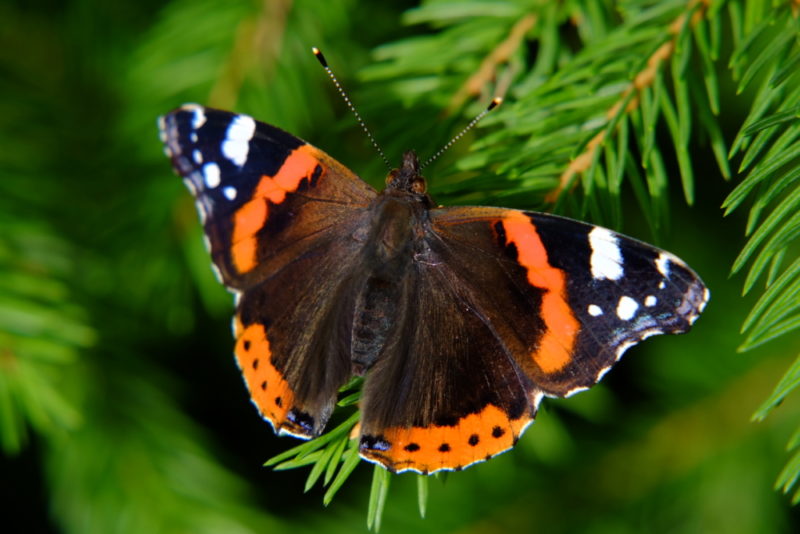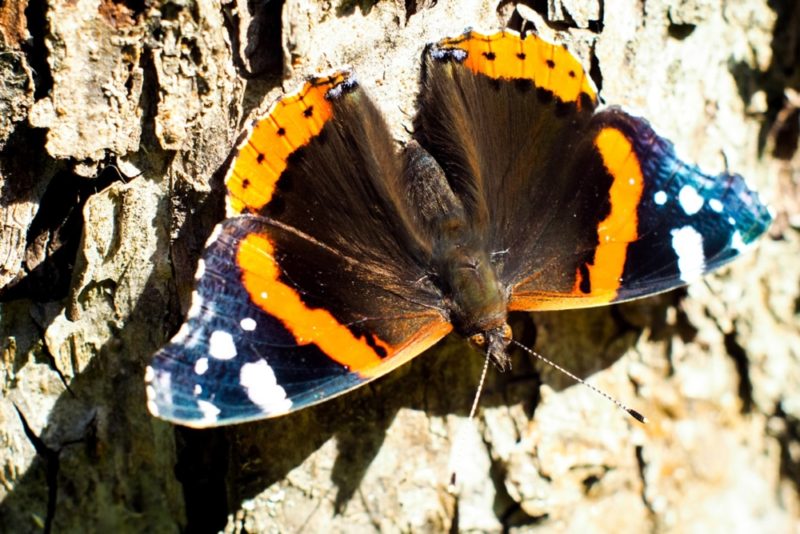Butterfly Admiral (Vanessa atalanta) - one of the most beautiful flying insects of the European continent. It is widespread, and its chaotic flight can often be observed on the lawns and flower beds in gardens and parks.
Material Content:
Description and features of butterfly admiral
Type Description:
- The imago has a bright, attractive color and an interesting shape of the wings. On a black or dark brown background, which seems velvety, there are bright orange or red stripes and white rounded spots. The edge of the upper blades is wavy, with a protrusion, has a narrow white border with black dots. On the orange stripes crossing the lower wings, there are also round black spots, and near the hind legs there are also blue marks.
- The body of the insect is powerful, slightly pubescent on the sides, expanded in the chest and thin at the end.
- Antennae long with large clubs.
- The front legs have sensory hairs, with which the imago receives information about food even before it reaches it with its twisted proboscis.
- The reverse side of the wings is not so brightly colored, but when they are open, the Admiral butterfly looks very attractive and even solemn.
Lepidoptera refers to migratory species. In autumn, most individuals leave their summer habitats and rush to the southern regions.
Some specimens remain wintering at sub-zero temperatures, clogging in tree crevices, small hollows, under the bark. But the survival rate is not high.
Insect habitat
The admiral is widespread in the middle lane and can be found everywhere - in forests, gardens, parks, lawns and flower beds, small clearings and meadows. Butterflies are active from May to the end of September. Do not shy away from the urban environment.In industrial areas, they are unlikely to be met, but in well-planted bedrooms, it is quite possible. Especially often these representatives of the Nymphalid family are observed on fruit trees (plums, pears), where they enjoy drinking viscous liquid from rotting fruits, or on large flower beds.
Nutrition and lifestyle
Vanessa atalanta feeds mainly on nectar, like most butterflies. It can be found with a spread proboscis on the inflorescences of clover, thistle, willow, dandelion, buddley, daisies, nettle and many other plants. Admiral's diet is supplemented not only by fermented fruit juice, but also by moisture from cow manure, saturated with nutrients. A whole group of butterflies can be seen on a heap of mullein or compost.
They eat and make flights only in the daytime, and in the evening they go on vacation to secluded places where they cannot be caught by night predators.
Reproduction and Life Cycle
The breeding season of these Nymphalids is from the beginning of June to the end of August. During the season, they give life to two new generations, and in successful years (if spring was warm and autumn cold came late) - and more. The fertilized female lays many eggs, attaching them one at a time to the bottom of the leaves of the plants. Most often, the choice falls on nettles or thistles. It is these species that are most readily eaten by Admiral caterpillars. Less commonly, they can be seen on long lashes of hops.
Hatching from an egg, the insect immediately begins to feed. Later it wraps a sheet around itself, fastening its edges with silk threads, and as if wrapped in it. This provides the larvae with additional protection from predators, although birds rarely attack these caterpillars, since the latter are covered with many hard bristles. It is known that only cuckoos can eat such unappetizing food.
When the caterpillar is ready for transformation, it builds up a dense cocoon around itself, turning into a beige pupa with several rows of small protrusions. These spikes probably serve the same purpose as the stiff bristles on the track body. After a while, a butterfly appears from the pupa, and the Admiral's life cycle repeats. The answer to the question how long does Admiral butterfly live is simple - no more than 9 - 10 months.
Interesting Facts
There is no single version of the origin of the name of this insect. Someone believes that its coloring is similar to the military uniform that admirals wore in tsarist Russia in former times. Red bandages on the wings of a butterfly resemble stripes.
It is believed that the name of the butterfly is a slightly modified French word admirable, which means "beautiful." The British sometimes refer to Nymphalida aldermann, which translates as "adviser."
The nature of the flight of these Lepidoptera is interesting. He seems completely chaotic and uncontrollable. It seems that the butterfly is simply picked up and circled by the wind. But it turns out that this is no accident. An unpredictable trajectory prevents birds and other predators from catching the prey.
Cases have been reported where Vanessa atalanta caterpillars displayed consistent behavior. When an external threat arises, they together raise the upper body and demonstrate tough spines, confusing and scaring away the aggressor.
Migrating to warmer regions, the Admiral can travel long distances. He easily reaches North Africa, starting his journey in Europe. True, not everyone experiences such a voyage. Individuals who survived a trip to warm countries and returned back to the European continent can be recognized by faded and slightly frayed wings.
The admiral is sometimes confused with the common urticaria, which is also widespread in the middle zone. It is noteworthy that the caterpillars of both species are fed on the same plants. The Admiral butterfly is larger and brighter than its double and has a more sophisticated wing color, in which black rather than orange colors prevail.But the caterpillars of these two species, indeed, are very similar.
Vanessa atalanta has not only a sonorous name, but a remarkable appearance. It is pleasant and interesting to watch the butterfly; both adults and children indulge in this activity with enthusiasm. Admiral deserves protection and respect. In some countries, it is listed in the Red Book.















